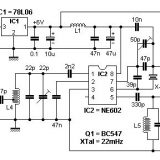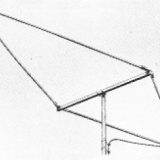Six Meters: An Introduction
Six Meters (50-54 MHz) is known as “The Magic Band” to many of its fans, but the best description I ever heard came from a ham I worked during a frantic summer Sporadic-E opening: “This is a great band if you like having Mother Nature pull your chain.”
On six meters, you can do almost anything that can be done on an HF band. Hams have earned WAS, WAC and DXCC on six. Six meters can sound like a contest weekend on 20, filled with signals and pileups galore. What makes it so different from the HF bands is that you never know when this excitement will come. That ear-blasting cacophony of signals can change into a completely dead band in only a few minutes. Or vice-versa!
Six meters offers nearly every kind of propagation known. At the peak of a sunspot cycle, when the solar flux rises to between 150 and 200, the F-layer skip familiar to HF operators can provide worldwide contacts on six. If the flux goes significantly above 200, DX work on six can even get fairly reliable. Propagation modes more familiar to VHF operators, such as sporadic-E, auroral, meteor-scatter, transequatorial and moonbounce, all have been used on six meters.
Sporadic-E is the most common workhorse for six-meter operators. Peaking around the solstices (June and December), this mode of propagation can provide contacts over a few hundred miles or a couple of thousand miles or more with a “double-hop.” It comes back every season, even during the sunspot minimum. Sporadic-E was essentially discovered by hams during the 1930s, when the old 5-meter band (56 MHz) produced contacts covering “impossible” distances. The “E-skip season” runs from May to July, with another, shorter, peak in December and early January, but this propagation mode can appear at any time. A sproadic-E opening typically lasts for a few hours. For a thorough discussion of Sporadic-E, see the article by Emil Pocock, W3EP, in the April 1988 issue of QST.
Stations for Six

Today, it’s easier than ever to get on six meters. Many of the newer HF rigs come with six-meter capability built in. There also are transverters, such as the ones from Ten-Tec, that will put your HF rig on six, and single-band rigs such as MFJ’s “Adventure Radio.” If you’re interested in DX, avoid the FM-only six-meter rigs and get one capable of CW and SSB operation. You don’t need a lot of power. When six is open, it’s open!
Antennas for this band are readily available commercially, but also easy to homebrew. A dipole for six meters is only a bit over nine feet long, and even a wire dipole, in a good location, will perform well. At this length, it also is easy to make a rotatable dipole from aluminum tubing. A three-element Yagi will perform admirably, and makes a nice weekend construction project. Ground-plane and J-Pole antennas also work fine for six meters.
While antenna polarization makes little difference for DX work, it is important if you also want to work other six-meter operators within ground-wave range. Most operators with Yagis or rotatable dipoles use horizontal polarization, so if you rely on a vertical ground-plane or J-Pole, you may miss out on local and regional six-meter nets, which can provide a nice way of keeping up with weak-signal VHF happenings. One way to get both polarizations in one antenna would be to build an “L” antenna for six, adapting the 10-meter design of W4RNL presented in the December 1999 QST, page 52.
Again, you don’t need an elaborate station to get good results on six meters. During one opening, I exchanged honest S-9-plus signal reports with a station several hundred miles away, then he asked about my station. When I said, “ten watts and a ground-plane antenna,” he laughed. His station: 1,500 watts and an array of four, 11-element Yagis. And the same signal report on both ends! (This guy uses his top-of-the-line station for six-meter moonbounce work.)
Getting on the air
Six-meter operators do a lot of waiting, because of the unpredictable nature of the band. To help show when the band is open, six-meter fans around the world have put a fairly extensive suite of beacons on the air. In the U.S., beacons occupy the region between 50.060 and 50.080 MHz. In other countries, beacons are spread more widely throughout the band. For lists of beacons, their frequencies, locations and other details, look at the following Web sites, which are updated regularly:
G3USF’s Worldwide List Of 50MHz Beacons
It’s a good idea to pick a few beacons in different directions from your QTH and check their frequencies regularly. During an opening, go through the beacon subband and note which ones you’re receiving, then watch for them later.
Unlike the HF bands, six meters is much more rigidly structured in terms of what frequencies are used for what purposes. Ironically, six meters, available to all no-code Techs, is one of only two ham bands (2 meters is the other) with a CW-only subband which excludes all data transmissions. That CW-only subband runs from 50.0 to 50.1 MHz. Almost all weak-signal activity on six occurs between 50.1 and 50.4 MHz.
Calling frequencies are used extensively. From 50.100 to 50.125 is a “DX Window,” in which domestic QSOs are discouraged. The DX calling frequency is 50.110. The traditional domestic calling frequency is 50.125. However, there has been a movement recently to extend the DX window to 50.130 and make 50.200 the new domestic calling frequency. This movement has been precipitated by the extension of six-meter privileges to hams in new countries around the world, and the associated increase in the number of DX stations on the air. Such band plans are, of course, voluntary, but are observed widely by the six-meter community.
The recommended CW calling frequency is 50.090, but you will often hear CW CQs on 50.125, too. Under the old band plan, you would hear many stations on 50.125 as the band opened up, then, as more stations discovered the opening, activity would spread upward in frequency, reaching 50.3 or 50.4 during a good opening. It seems likely that, while the new, expanded DX window probably will catch on, many operators will take some time to “let go” of the old, familiar 50.125. I would recommend monitoring both 50.125 and 50.200, as well as 50.090, during an opening. If the opening seems real good, start checking 50.110 for DX stations, too.
Most domestic weak-signal contacts on six are SSB, but in recent years, there has been an increase in CW activity. As mentioned above, the CW activity often is intermingled freely among the SSB signals. It would be nice to see more CW activity down around 50.090, and use the CW-exclusive subband to better advantage.
The first thing you will be asked when you make a contact on six is, “what’s your grid square?” While still little known among HF operators, the Maidenhead grid-square system, formalized at a VHF meeting in Britain in 1980 and adopted world-wide by the International Amateur Radio Union in 1985, is almost universally used as a locator system by VHF, UHF and microwave operators. The Maidenhead system divides the world into 32,400 squares, each 2 degrees of longitude by 1 degree of latitude. There are larger “fields” of 100 locator squares each, and each square is divided into smaller “subsquares.” For most purposes, knowing your 2 degree by 1 degree square is sufficient.
VHF operators collect grid squares like HF operators collect countries. Many are working toward the ARRL’s VHF-UHF Century Club (VUCC) award, which requires confirmed contacts with 100 grid squares. During VHF contests, some enthusiasts go on “Gridexpeditions,” to put rare grid squares on the air, while others become “rovers” to operate from several grids during the contest. Just as states or countries serve as multipliers for HF-contest scores, grid squares are the typical multipliers for VHF-contest scores.
You can find a grid-square map of the U.S. here or you can plug your latitude and longitude into AMSAT’s grid-square calculator.
If you work much on six meters at all, you’ll probably want to add your grid square to the information on your QSL card.
More information on the Web
Many hams have become rather fanatical about six meters, and there is a wealth of information about this band on the Web. To learn more, you can start at the site of the Six Meter International Radio Klub (SMIRK).
You can earn a lifetime membership in SMIRK by working six members on six meters and collecting their SMIRK membership numbers. SMIRK sponsors contests, publishes a newsletter and meets annually.
Another good Web site is provided by the UK Six Metre Group.
Six meters can provide you with a lot of excitement and new operating challenges. In addition to offering new awards and contests, this band can expand your experience with different propagation modes.
Finally, in my opinion, six meters serves a valuable function for the health of Amateur Radio. All licensed hams except for Novices can use six meters. In recent years, no-code Technicians have discovered this band in increasing numbers. When someone whose only experience with Amateur Radio has been local operation on 2-meter repeaters makes a six-meter contact with another ham more than 1,000 miles away, that can be a dramatic revelation that opens up a whole new world to them. In many cases, such a revelation spurs that ham to upgrade their license and join us on the HF bands. When that happens, we have, in all likelihood, gained a lifelong radio devotee who otherwise might have dropped from our ranks from boredom. By showing such hams the wider world of our hobby, six meters earns its appellation of “The Magic Band.”


















Last Comments